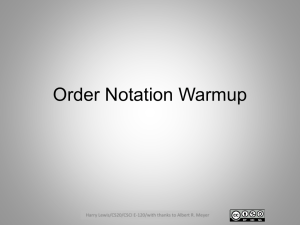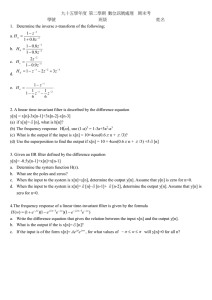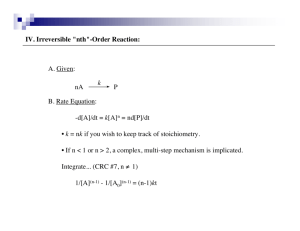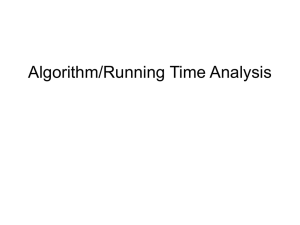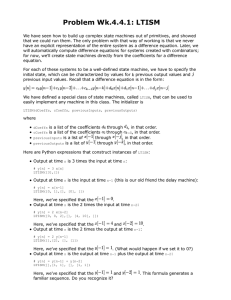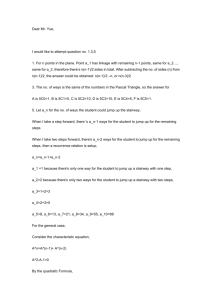Great Theoretical Ideas In Computer Science Steven Rudich Lecture 2
advertisement
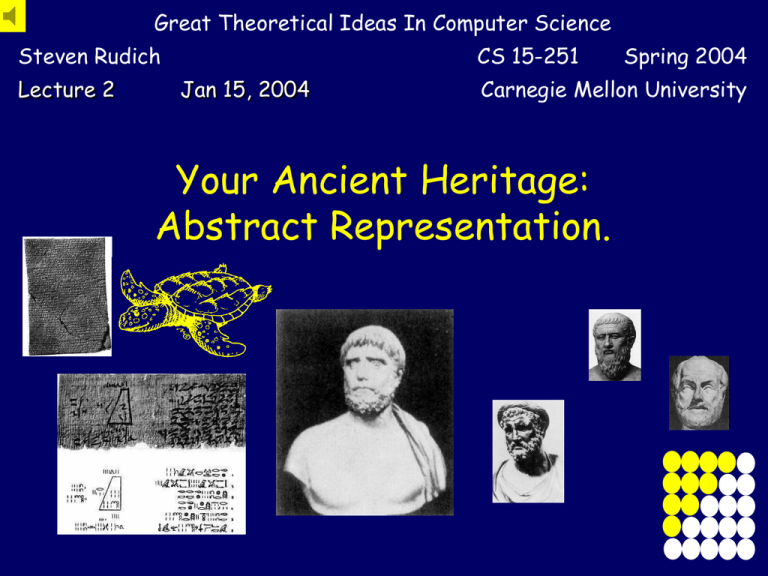
Great Theoretical Ideas In Computer Science Steven Rudich Lecture 2 CS 15-251 Jan 15, 2004 Spring 2004 Carnegie Mellon University Your Ancient Heritage: Abstract Representation. How to play the 9 stone game? 1 2 3 4 5 6 9 7 8 9 stones, numbered 1-9 Two players alternate moves. Each move a player gets to take a new stone Any subset of 3 stones adding to 15, wins. For enlightenment, let’s look to ancient China in the days of Emperor Yu. A tortoise emerged from the river Lo… Magic Square: Brought to humanity on the back of a tortoise from the river Lo in the days of Emperor Yu 4 9 3 2 5 8 7 1 6 Magic Square: Any 3 in a vertical, horizontal, or diagonal line add up to 15. 4 9 2 3 5 7 8 1 6 Conversely, any 3 that add to 15 must be on a line. 4 9 2 3 5 7 8 1 6 TIC-TAC-TOE on a Magic Square Represents The Nine Stone Game Alternate taking squares 1-9. Get 3 in a row to win. 4 9 2 3 5 7 8 1 6 BIG IDEA! Don’t stick with the representation in which you encounter problems, always seek the more useful one! This IDEA takes practice, practice, practice to understand and use. Your Ancient Heritage Let’s take an historical view on abstract representations. Mathematical Prehistory: 30,000 BC Paleolithic peoples in Europe record unary numbers on bones. 1 represented by 1 mark 2 represented by 2 marks 3 represented by 3 marks 4 represented by 4 marks … Wait a minute! Isn’t calling unary an abstract representation pushing it a bit? No! In fact, it is important to respect the status of each representation, no matter how primitive. Unary is a perfect object lesson. Consider the problem of finding a formula for the sum of the first n numbers. First, we will give the standard high school algebra proof…. 1 + 2 + n + n-1 + 3 + ... + n-1 + n = S n-2 + ... + 2 1 = S (n+1) + (n+1) + (n+1) + ... + (n+1) + (n+1) = 2S n (n+1) 2S + = 1 + 2 + n + n-1 + 3 + ... + n-1 + n = S n-2 + ... + 2 1 = S (n+1) + (n+1) + (n+1) + ... + (n+1) + (n+1) = 2S n (n+1) 2S + = 1 + 2 + n + n-1 + 3 + ... + n-1 + n = S n-2 + ... + 2 1 = S (n+1) + (n+1) + (n+1) + ... + (n+1) + (n+1) = 2S n (n+1) 2S + = 1 + 2 + n + n-1 + 3 + ... + n-1 + n = S n-2 + ... + 2 1 = S (n+1) + (n+1) + (n+1) + ... + (n+1) + (n+1) = 2S n (n+1) 2S n (n 1) S 2 + = 1 + 2 + n + n-1 + 3 + ... + n-1 + n = S n-2 + ... + 2 1 = S + Algebraic argument (n+1) + (n+1) + (n+1) + ... + (n+1) + (n+1) = 2S n (n+1) 2S = Let’s restate this argument using a UNARY representation 1 + 2 + n + n-1 + 3 + ... + n-1 + n = S n-2 + ... + 2 1 = S (n+1) + (n+1) + (n+1) + ... + (n+1) + (n+1) = 2S n (n+1) 2S + = = number of white dots. 1 2........n + ... + n-1 + n = S = number of white dots n-2 + ... + 2 1 = S = number of yellow dots (n+1) + (n+1) + (n+1) + ... + (n+1) + (n+1) = 2S n (n+1) 2S 1 + 2 + n + n-1 + 3 n ....... 2 1 + = 1 2........n + ... + n-1 + n = S = number of white dots n-2 + ... + 2 1 = S = number of yellow dots (n+1) + (n+1) + (n+1) + ... + (n+1) + (n+1) = 2S n (n+1) 2S 1 + 2 + n + n-1 + 3 + = n n There are n(n+1) dots in the grid n n n n n+1 n+1 n+1 n+1 n+1 + ... + n-1 + n = S = number of white dots n-2 + ... + 2 1 = S = number of yellow dots (n+1) + (n+1) + (n+1) + ... + (n+1) + (n+1) = 2S n (n+1) 2S 1 + 2 + n + n-1 + 3 + = n n (n 1) S 2 n n n n n n+1 n+1 n+1 n+1 n+1 Very convincing! The unary representation brings out the geometry of the problem and makes each step look very natural. By the way, my name is Bonzo. And you are? Odette. Yes, Bonzo. Let’s take it even further… nth Triangular Number n = 1 + 2 + 3 + . . . + n-1 + n = n(n+1)/2 nth Square Number n = n + n-1 = n2 Breaking a square up in a new way. 1 Breaking a square up in a new way. 1+3 Breaking a square up in a new way. 1+3+5 Breaking a square up in a new way. 1+3+5+7 Breaking a square up in a new way. 1+3+5+7+9 Breaking a square up in a new way. 1 + 3 + 5 + 7 + 9 = 52 The sum of the first 5 odd numbers is 5 squared The sum of the first n odd numbers is n squared. Pythagoras Here is an alternative dot proof of the same sum…. nth Square Number n = n + n-1 = n2 nth Square Number n = n + n-1 = n2 Look at the columns! n = n + n-1 = Sum of first n odd numbers. High School Notation n + n-1 = 1 + 2 + 3 + 4 + 5 ... + 1 + 2 + 3 + 4 ... 1+3+5+7+9… Sum of odd numbers Check the next one out… ( n-1)2 ( n-1)2 n-1 = area of square ( n)2 = area of square nn + nn-1 n = n (n + n-1) = n n ( n-1)2 n-1 = n n = area of pieces ( n)2 = ( n-1)2 + n ( n-1)2 n-1 n n ( n)2 = ( n-1)2 + ( n)2 = + +...+ n n Can you find a formula for the sum of the first n squares? The Babylonians needed this sum to compute the number of blocks in their pyramids. The ancients grappled with problems of abstraction in representation and reasoning. Let’s look back to the dawn of symbols… Sumerians [modern Iraq] 8000 BC Sumerian tokens use multiple symbols to represent numbers 3100 BC Develop Cuneiform writing 2000 BC Sumerian tablet demonstrates: base 10 notation (no zero) solving linear equations simple quadratic equations Biblical timing: Abraham born in the Sumerian city of Ur Babylonians absorb Sumerians 1900 BC Sumerian/Babylonian Tablet Sum of first n numbers Sum of first n squares “Pythagorean Theorem” “Pythagorean Triplets”, e.g., 3-4-5 some bivariate equations Babylonians 1600 BC Babylonian Tablet Take square roots Solve system of n linear equations Egyptians 6000 BC Multiple symbols for numbers 3300 BC Developed Hieroglyphics 1850 BC Moscow Papyrus Volume of truncated pyramid 1650 BC Rhind Papyrus [Ahmose] Binary Multiplication/Division Sum of 1 to n Square roots Linear equations Biblical timing: Joseph is Governor of Egypt. Rhind Papyrus Scribe Ahmose was the Martin Gardener of his day! Rhind Papyrus 87 Problems. A man has seven houses, Each house contains seven cats, Each cat has killed seven mice, Each mouse had eaten seven ears of spelt, Each ear had seven grains on it. What is the total of all of these? Sum of first five powers of 7 Harrappans [Indus Valley Culture] Pakistan/India 3500 BC Perhaps the first writing system?! 2000 BC Had a uniform decimal system of weights and measures China 1500 BC Independent writing system Surprisingly late. 1200 BC I Ching [Book of changes] Binary system developed to do numerology. Ancient interest in Magic Squares and whole numbers (Number Theory) is echoed by modern Chinese research emphasis and taste. The ancient minds sought and found patterns in numbers and forms. They gave useful calculation methods (specified by examples) for fundamental problems. They understood how to communicate patterns and calculation methods, but they lacked the idea of PROOF ! Enter the ancient Geeks! I meant .. Enter the ancient Greeks! My greatest intellectual hero of all time is My greatest methodological hero of all time is Thales Of Miletus (600 BC) Thales traveled in Egypt and (probably) Babylon, where he learned the Geometry and Astronomy of the time. Thales Of Miletus (600 BC) Insisted on Proofs! “first mathematician” Most of the starting theorems of geometry. SSS, SAS, ASA, angle sum equals 180, . . . Thales Of Miletus (600 BC) Use theory to do amazing things! Measured height of the Pyramids Measured distance to ships Predicted Solar eclipse of 585 BC Articulated basic idea of theory/experiment interaction for science Thales Of Miletus (600 BC) Absent minded professor Fell down a well while contemplating the heavens Made up for well by using the power of theory to predict bumper olive crop, buying up all the presses, and cornering market on olive oil. Thales Of Miletus (600 BC) “All is water” Wondered if the world was made of one thing, or many, and whether it was discrete or continuous. Pythagoras of Sarnas [Turkey, 570-500BC] “All is number” Greatly inspired by Thales. Founded the Pythagorean School. Mystical society of “mathematicians” meaning “the study of learned things”. “mathematics” was later given modern meaning by Aristotle . Pythagoras of Sarnas “All is number” Pythagoreans: Gave the dot proof of the sum of first n numbers. Gives first proof of “Pythagorean” theorem. Showed sqrt(2) is irrational. Formula for perfect numbers. Constructed dodecahedron 460 BC Zeno of Elea The man of paradoxes Constructed several famous paradoxes of motion. Tortoise and Achilles Race Paradox: Tortoise gets head start. Achilles must catch up. But Tortoise still has advantage. Achilles must catch up …. 430 BC Hippocrates of Athens Pioneered “Reductio Ad Absurdum” Proof by contradiction. Assume X, derive contradiction. Conclude NOT X. Explicitly writes mathematics by reducing one theorem to another. 408-355 BC Eudoxus of Athens Defined Golden ratio. “Proved” area of circle is proportional to the square of its diameter. [Archimedes is credited with giving the first complete, modern proof of this formula.] 408-355 BC Eudoxus of Athens Defined and proved that the product of two real numbers is commutative and associative! Especially amazing given that real number were not invented yet! Great Philosophers 427 – 347 BC Plato of Athens Founds Academy in 380 Believes that mathematical objects are real, in fact, more real than the “real” world. “Plato’s Heaven” 384 – 322 BC Aristotle Completely codifies rules of logic Takes a contrary view of “Plato’s Heaven” The Great Debate! Aristotle: Plato’s Heaven: There is a place (or a sense) in which the infinity of counting numbers exists (0, 1, 2, …. ). We have no direct evidence of infinity. Infinity is an idea in our mind, not something that exists outside of our conception of it. Let me ask you, do the infinity of counting numbers exist in a sense that does not depend on the existence of minds to conceive them? By the end of this course, you will come to appreciate the depth and relevance of the issue. 300 BC Euclid Of Athens First chair of mathematics at the Museum (University) of Alexandria Organized the project of writing the “Elements”. A book that gave one consistent derivation of important Greek mathematics to date. 287-212 BC Archimedes of Syracuse r2. 4/3 r3. Area of conics. Volume by water immersion. Percentage of silver/gold Crane to drop ships and destroy them Lob huge stones at ships Discovered Integration Modern Times The history of mathematics can be cast as the discovery and manipulation of abstract representations. Nothing has changed – a good computer scientist will invent representations to make computation easy. A case study. Anagram Programming Task. You are given a 70,000 word dictionary. Write an anagram utility that given a word as input returns all anagrams of that word appearing in the dictionary. Examples Input: CAT Output: ACT, CAT, TAC Input: SUBESSENTIAL Output: SUITABLENESS Impatient Hacker (Novice Level Solution) Loop through all possible ways of rearranging the input word • Use binary search to look up resulting word in dictionary. • If found, output it Performance Analysis: Counting Without Executing On input "microphotographic" the loop will run though 17 ! 3 1014 iterations. -6 Even at one microsecond (10 ) per iteration this will take 3 108 seconds. This is about a decade! (About seconds in a nanocentury (10-9 )) “Expert” Hacker Subroutine ANAGRAM(X,Y) returns TRUE exactly when X and Y are anagrams. It works by sorting the letters in X and Y Input X Loop through all dictionary words Y • If ANAGRAM(X,Y) output Y Comparing an input word with each of 70,000 dictionary entries takes about 15 seconds. The hacker is satisfied and reflects no further The master keeps trying to refine the solution. The master’s program runs in less than 1/1000 seconds. Master Solution Don’t keep the dictionary in sorted order! Rearranging the dictionary into anagram classes will make the original problem simple. Suppose the dictionary was the list below. ASP DOG LURE GOD NICE RULE SPA After each word, write its “signature” (sort its letters) ASP DOG LURE GOD NICE RULE SPA APS DGO ELRU DGO CEIN ELRU APS Sort by the signatures ASP SPA NICE DOG GOD LURE RULE APS APS CEIN DGO DGO ELRU ELRU Master Program Input word W X := signature of W Use binary search to find the anagram class of W and output it. About log2 ( 70,000) 25 microseconds .0004 seconds Of course, it takes about 30 seconds to create the dictionary, but it is perfectly fair to think of this as programming time. The building of the dictionary is a one-time cost that is part of writing the program. Neat! I wish I had thought of that. Name Your Tools Whenever you see something you wish you had thought of, try and formulate the minimal and most general lesson that will insure that you will not miss the same thing the next time. Name the lesson to make it easy to remember. NAME: Preprocessing It is sometimes possible to pay a reasonable, one-time preprocessing cost to reorganize your data in such a way as to use it more efficiently later. The extra time required to preprocess can be thought of as additional programming effort. Of course, preprocessing is just a special case of seeking the appropriate representation. Don’t let the representation choose you, CHOOSE THE REPRESENTAT ION! References The Heritage of Thales, by W. S. Anglin and F. Lambek The Book Of Numbers, by J. Conway and R. Guy Programming Pearls, by J. Bentley History of Mathematics, Histories of Problems, by The Inter-IREM Commission

